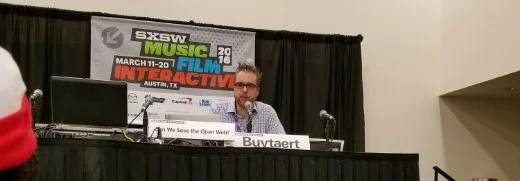[ad_1]
Can we save the open web? Dries Buytaert, creator of Drupal, talked to a group during SxSW Interactive about how he began the content management service (CMS) Drupal in his dorm room in 2001. Today, Drupal powers 1 out of 30 websites in the world. Technology has changed a lot from 2001 to 2016. Back in 2001, only 7% of the population had Internet access, there were only 20 million websites, and text messaging was just introduced. So, when we talk about the open web what we’re talking about is people having choice and transparency in their options.

The open web has these characteristics:
- creative freedom
- serendipitous discovery
- control over your own experience and privacy
- a decentralized web
An open web was the state of the web when it first began, and the original intention of Tim Berners-Lee, the inventor of the world wide web. A newly released option for browsing the web is Brave, created to provide more control and privacy.
The closed web has these characteristics:
- template driven
- run by algorithms that determine what you see
- privacy is in question
- information is siloed
A closed web is what we saw during the AOL generation. Users were limited in their access to the web by portals until the invention of browsers.
Though companies like Facebook and Google implement ways to lock content behind a login, these powerful companies are not the enemy, and it’s important to note the good they have done, like enable democratization and communication. The concern we should have with these companies is over their size and power for what gets delivered to us in our feeds and search results. These tools can shape the news we see, for instance. They are also recording a lot of data about us. Try searching Google for “Recent Amazon Purchases.” Do you see something you bought in the list of results?
So, why does it feel like the closed web is winning right now? Dries says, because it’s easy. It’s easy to use Google for our daily needs, and it’s easy to connect with friends and family on Facebook. That ease of use is driving the adoption of the closed web (and sometimes of closed source software as well). The solution? We can design better user experiences for the open web and open source.
What we need for an open web
Algorithm oversight: A possible solution is FDA for data and algorithms, but then how do they validate algorithms? Should government be involved? This is really a global problem and so how do we solve this problem globally? It’s also possible that this would hurt the smaller players by being to expensive and complicated.
Data privacy and control: A possible solution is the personal information broker. Should we take th personal information out of the big products and store it in one place and let the user decide what to share and where and how long to share it. If we had something like this, how do we convince the walled gardens to adopt this? This might have a big impact on their business models. And who would build it?
Decentralization and better user experience: This is where open source and open standards can really help. Open standards aren’t enough though because there is no user experience here, that’s why we need to pair it with open source. The problem here is how do we compete with a walled garden like Google or Facebook with the resources they have?
Remember, open source software can build successful (and large) businesses and communities that can compete—look at Drupal’s 35,000 active contributors around the world!
[ad_2]
Source link